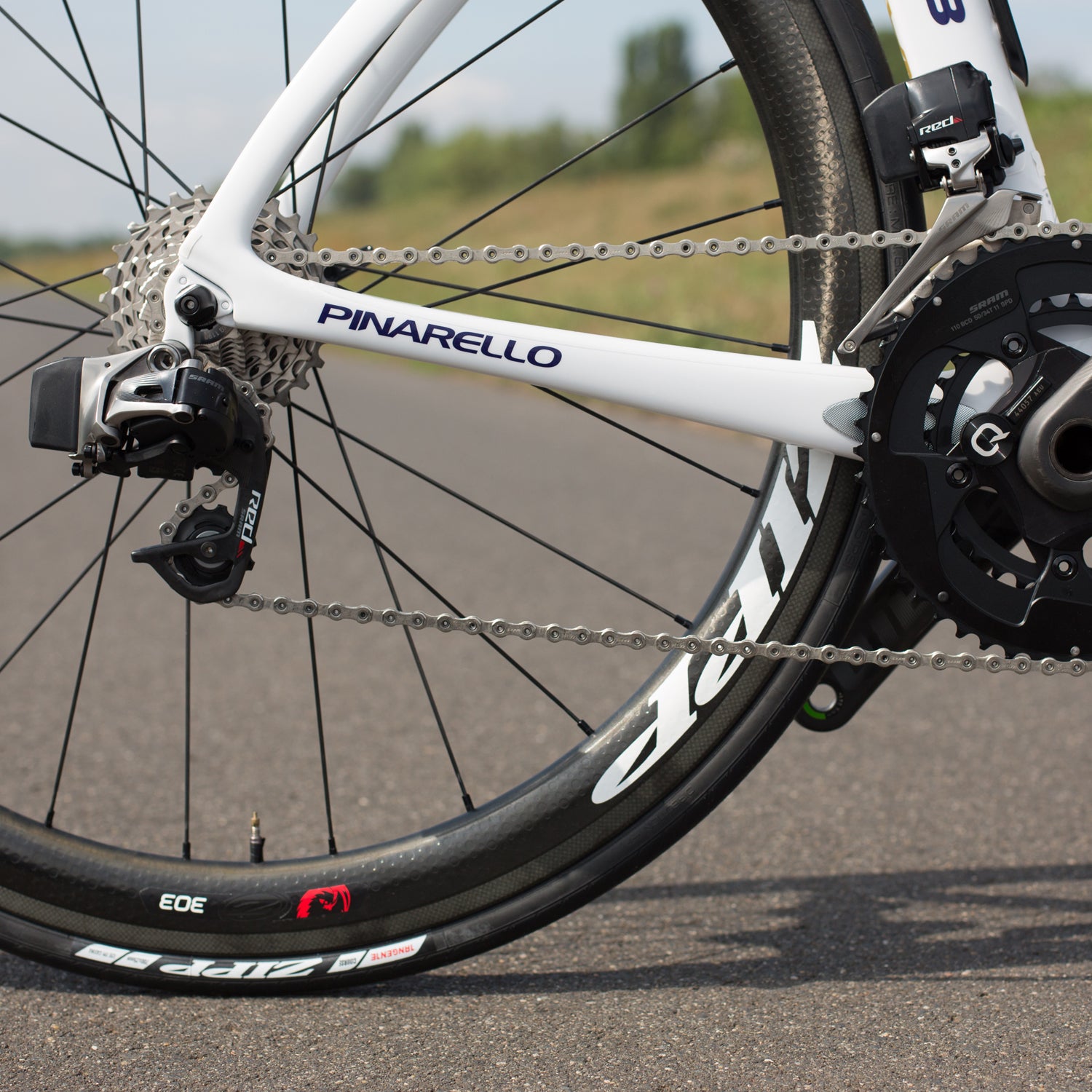It took SRAM almost seven years longer than Shimano to release an electronic group set. But after nearly six months and over 1,000 miles of testing it, we can say—resoundingly—that it was worth the wait. The new parts, , aren’t faultless, but they are closer to perfection than anything else on the market.
Two things set eTap above the rest. First and foremost, it's wireless, which makes setup and tuning far easier than with existing wired systems. Without cables to worry about, you simply stick the components on your bike and pair them (using SRAM’s proprietary 128-bit wireless encryption system, called Airea). That's it. There’s no tricky cables to route through the frame and nothing to rattle off. With certain Shimano Di2 setups, the battery occasionally unplugs or a cable pops loose. We had no such issues with eTap: the pairing was simple, quick, and never failed.
The wireless technology also lets you place satellite shifters, called Blips, anywhere you like. Whereas Shimano has separate Sprint shifters (for the drops) and a Climber shifter (for the tops), Blips can go in either spot. And SRAM’s circular design, with its two-centimeter-diameter, is tidier than Shimano's Climber shifter and requires more pressure to engage, so you never inadvertently change gears. We tucked our Blips neatly on the underside of the bar tops, where they were easy to engage with our pointer fingers but completely hidden from view.
Another advantage of wireless: frame manufacturers no longer need to drill and mold holes, or provide separate fitments for each brand’s component group. That means frames can be built both stronger and lighter, though that’s mostly a theoretical advantage at the moment since brake cables still route internally and bike manufacturers will continue to need to accommodate Shimano, Campy, and SRAM mechanicals.
ETap’s real virtue, however, is the new shifting mechanism that SRAM devised. There’s only one button on each controller, with the right controller moving the chain down in back, the left moving it up, and both buttons at once toggling between big and small in front. That might sound confusing at first, but it's blessedly simple in practice. After a single quick lap on the new gear, we found ourselves constantly trying to shift other components the same way, which speaks to just how instinctive a system SRAM has devised.
And the benefits are more than theoretical. Unlike Di2, where the dual buttons are a bit vague and hard to distinguish from one another, eTap ensures that you never accidentally shift the wrong way. And, like Di2, the buttons can be held down until you dump gears and reach whatever position in the chain ring you need.
Shifting quality is high and retains SRAM’s solid audible and tactile feel. Unlike Di2, which feels and sounds silky, eTap shifts with a resounding, almost harsh snap, which some riders prefer and some don’t. On the upside, you never question whether or not you’ve shifted; downside is it doesn’t feel as refined as Shimano's. Similarly, shift speed is nominally slower than SRAM Red mechanical and Dura Ace, but it’s nothing that impedes performance—it's just different. The only thing negative we noticed was that eTap doesn’t stay true like Dura Ace does: ours required a few tweaks and small tune-ups over the course of the review. Di2 maintains its flawless shifting almost indefinitely.
We also liked eTap’s battery design, with a matchbook-size rechargeable for the derailleurs and watch-style CR2032 batteries in the shifters and Blips. Battery life is said to be between 50 and 60 hours on derailleurs, and we only charged them once between the holiday season and Paris-Roubaix. We also liked that, since the batteries are identical, if one of the derailleur batteries dies on a ride, you can swap the rear with the front (which likely gets less use) to make it home.
Other than the drift in shifting performance over time, the only other niggle we had was with crank design, which makes you choose between compact and standard. Given the expense, we’d prefer to be able to swap these out rather than have to invest in a completely new crank set.
The inevitable question: Should you upgrade? Of course, the answer depends on your finances and your predilections. Will Red eTap make you a better rider than Red mechanical or even Force, Ultegra, or 105—probably not. Shift quality across all the major groups is very high, and weights continue to drop. And some riders will likely still prefer the feel of Di2 and Campy EPS.
But eTap is the pinnacle of cutting-edge bike tech. If you’re one who likes the best and wants to be on that cutting edge, this is the ticket. We had several testers say they would swap their Di2 groups for eTap’s more intuitive shifting. And the group is important, too, because it could shepherd in lower-priced, wireless electronic shifting for the masses.
So far we’ve had (and heard of) zero long-term durability issues, and we like that SRAM is quickly rolling out auxiliary products, such as BlipGrips for TT bars and BlipClamps for simpler placements. And though it’s expensive—$2,758 for a full group, or $1,250 for just shifters and derailleurs to work with existing 11-speed setups—we fully expect lower-tier, spinoff groups in the near future. Though SRAM won’t comment, we’re impatient for a mountain-bike version, where the wireless technology should make for an even bigger advantage.


